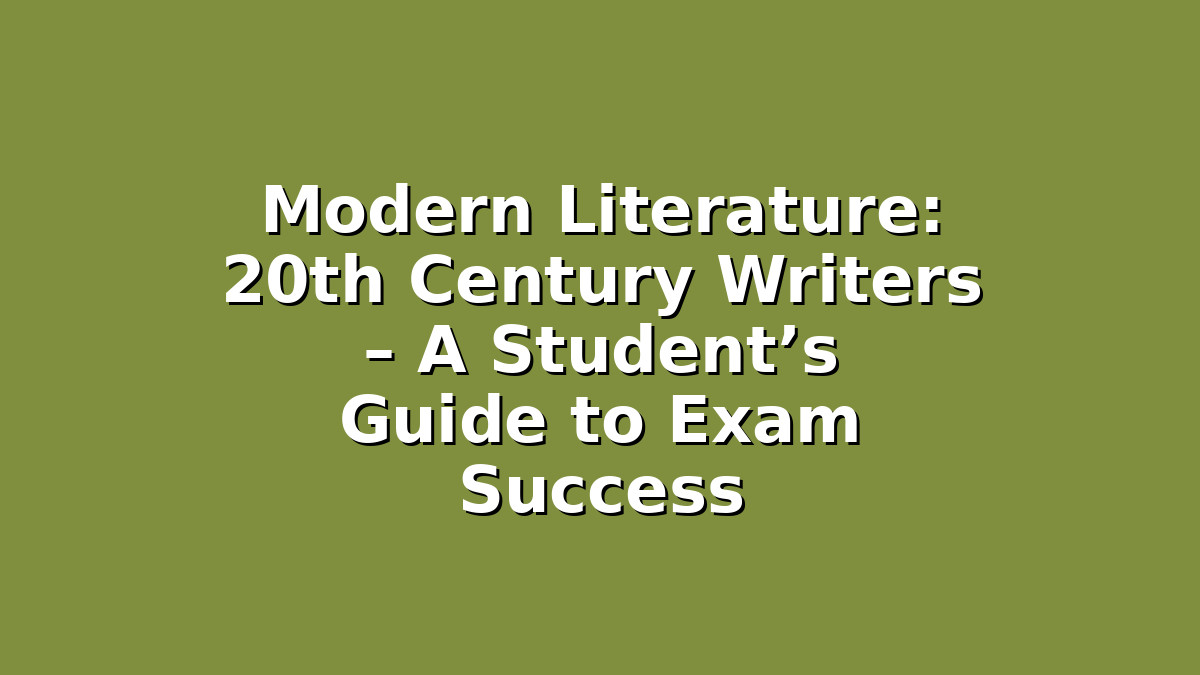The 20th century was a remarkable period for literature, bringing forth some of the most influential and diverse writers in history. For students preparing for exams, understanding the key figures and movements of modern literature is essential not only to grasp the evolution of literary styles but also to develop strong analytical skills. Whether you’re tackling English literature exams or simply looking to deepen your knowledge, this guide will help you approach 20th century writers with confidence and effective study strategies.
Understanding the Context: Why Study 20th Century Writers?
Before diving into individual authors, it’s important to understand the backdrop against which modern literature emerged. The 20th century was a time of rapid change, marked by two world wars, technological advancements, and shifting social norms. These events influenced writers deeply, pushing them to experiment with form and content in ways that challenged traditional narratives.
For students, this means that 20th century literature is often complex, layered with symbolism, and rich in social commentary. To succeed in exams, you need more than just memorizing facts; you must engage critically with texts and themes. Here are three detailed sections with study-related advice to help you master this fascinating era.
1. Familiarize Yourself with Major Movements and Authors
One of the keys to understanding modern literature is recognizing the major literary movements that shaped the 20th century. Each movement offers unique perspectives and techniques that reflect the concerns of its time.
– Modernism: Characterized by a break with traditional forms, modernist writers like James Joyce, Virginia Woolf, and T.S. Eliot experimented with narrative structures and language to express the complexities of the inner mind and fractured realities. For example, Joyce’s *Ulysses* employs stream of consciousness to immerse readers into the protagonist’s thoughts.
– Postmodernism: Emerging later in the century, postmodernism is known for its skepticism, irony, and playful use of language. Writers such as Kurt Vonnegut and Thomas Pynchon questioned objective truths and often blurred the boundaries between fiction and reality.
– Other Influential Figures: Don’t forget important poets like W.H. Auden and Sylvia Plath, novelists like F. Scott Fitzgerald and George Orwell, and playwrights like Samuel Beckett.
Study Tip: Create a timeline or mind map to visualize the connections between literary movements and authors. This will help you remember key characteristics and see how historical events influenced literary styles.
2. Develop Analytical Skills Through Close Reading
Exam questions often require you to analyze texts closely, so honing this skill is crucial. When studying a text by a 20th century writer, focus on the following:
– Language and Style: Notice how authors use experimental techniques. For instance, Woolf’s use of stream of consciousness can seem challenging at first but reveals characters’ inner lives vividly. Identify metaphors, symbolism, and imagery that deepen the meaning.
– Themes and Context: Consider the broader themes, such as alienation, identity, war, or social change. Understanding the historical and cultural context will enrich your interpretation. Orwell’s *1984*, for example, is more impactful when you know about the rise of totalitarian regimes during the mid-20th century.
– Structure and Form: Many 20th century writers played with non-linear narratives or fragmented structures. Try to outline the plot or sequence of events to see how the structure affects your understanding.
Study Tip: Practice annotating passages by highlighting key phrases and writing notes in the margins. This active reading approach keeps you engaged and prepares you for essay writing.
3. Use Past Papers and Model Answers to Build Confidence
Exams can feel overwhelming, but practicing with real questions is the best way to build confidence and improve your writing skills. Here’s how to make the most of past papers and model answers:
– Identify Common Question Types: Questions may ask for character analysis, thematic exploration, comparisons between texts, or evaluations of literary techniques. Familiarity with these types helps you plan your answers faster during the exam.
– Plan Your Essays: Before writing, spend time outlining your main points. A clear introduction, well-organized body paragraphs, and a strong conclusion will impress examiners.
– Review Model Answers: Reading high-scoring essays gives insight into what examiners expect. Notice how ideas are supported with evidence and how quotations are integrated smoothly.
– Time Yourself: Simulate exam conditions by timing your responses. This trains you to write clearly and concisely under pressure.
Study Tip: Form or join a study group where you can discuss past paper questions and exchange feedback on your essays. Explaining your ideas out loud often deepens your understanding.
Conclusion
Studying 20th century writers can be a rewarding experience that sharpens your critical thinking and exposes you to a variety of literary voices and styles. By familiarizing yourself with major movements and authors, developing close reading and analytical skills, and practicing exam techniques with past papers, you’ll be well-prepared to tackle literature exams confidently.
Remember, the key to success is consistent, active engagement with the texts and not just passive reading. Take the time to explore the world these writers created, and you’ll find your appreciation and understanding grow, making exam preparation a more enjoyable journey.
Good luck, and keep reading!

Responses